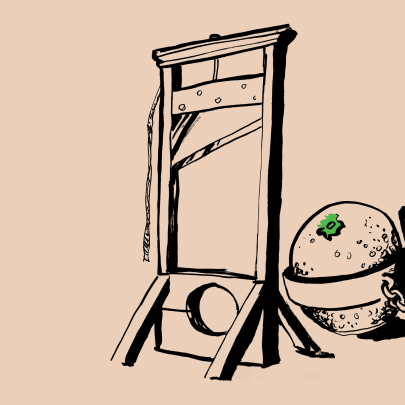Jan 12, 2016 Politics
Photo: Facebook
The voluntary euthanasia campaigner who died last year has become a powerful symbol of the struggle to reform the law. It was only a matter of time before she and her husband came under attack.
Read more: Voluntary euthanasia: too hot to handle?
Opponents of assisted dying must have choked on their cereal when they read in mid-December that the NZ Herald had selected assisted-dying campaigner Lecretia Seales as its New Zealander of the Year.
No matter what the paper’s editorials or columnists might say on the subject of assisted dying (and they have often enough opposed it), this was a powerful endorsement of law reform by the biggest newspaper in the country.
It’s not a formal endorsement of assisted dying like that made by Britain’s Economist magazine last year or by The Age newspaper in Melbourne, which are both campaigning for a law change, but the NZ Herald has always been slow to embrace progressive movements — often much slower than most of its readers. Now the Herald has formally endorsed an assisted dying advocate, opponents of law reform are surely on notice that they can’t hold back the tide of history in New Zealand forever.
Even more significant, assisted dying is to be mulled by the Health Select Committee after a petition (sparked by Seales’ campaign and signed by nearly 9000 people) was presented to Parliament in June. It asked: “That the House of Representatives investigate fully public attitudes towards the introduction of legislation which would permit medically assisted dying in the event of a terminal illness or an irreversible condition which makes life unbearable.”
While the committee can only make recommendations and cannot even force a debate in the House, it is the first time Parliament has allowed the subject to come under such scrutiny. (The committee is accepting submissions until February 1, 2016.)
At some point, more politicians will begin to realise that championing assisted dying is no longer an electoral liability — as most appear to believe — but an asset.
At some point, more politicians will begin to realise that championing assisted dying is no longer an electoral liability — as most appear to believe — but an asset.
Act MP David Seymour has done himself and his party a world of political good by lodging a member’s bill to allow mentally competent adults with a terminal illness likely to be fatal within six months, or suffering an irremediable condition in an advanced state of decline, the choice to ask a doctor to help to end their life at a time of their choosing. It is perfectly consistent with Act’s emphasis on individual choice and autonomy and has received support from the Voluntary Euthanasia Society, Seales’ widower Matt Vickers, National MP Chris Bishop and former New Zealand First deputy leader Peter Brown, who submitted a member’s bill on assisted dying in 2003 that was narrowly defeated. It is also in step with the wishes of the vast majority of New Zealanders.
Unfortunately, opponents of reform, led by the Catholic church and other religious groups, have mounted a campaign laced with misinformation to try to wrest control back into their hands. Seymour is blunt about his opponents’ tactics. In his party’s newsletter, he writes: “The Bible says thou shalt not lie but some assisted dying opponents must think they’re specially exempted. If they’re not breaking the letter of the commandments they are certainly outside their spirit. We do not say this lightly — the dishonesty in their campaign is breath-taking.”
Ken Orr of the Catholic lobby group Right to Life was among those not best pleased by the NZ Herald’s award. He produced a press release on December 23: “Lecretia Seales — NOT the New Zealander of the Year”, describing the accolade as “unfortunate and inappropriate”.
Unfortunately for Orr, he was clearly seen as a Christmas grinch because, as far as I can tell, no major news organisation found his announcement to be worth repeating. The decision by the Herald to honour Seales has been widely admired, and Orr might as well have written: “Sir Edmund Hillary — NOT a top bloke”.
Orr pronounced himself very pleased with Justice David Collins’ judgment on Seales’ application to allow her GP to assist her to die, describing it as “commendable and just” inasmuch as the judge rejected it. Nevertheless, the judge was clearly very sympathetic to Seales’ arguments and plight (imminent death from a brain tumour) but he believed a decision in her favour fell outside his jurisdiction and Parliament should decide.
As he put it, Seales’ application was a “rational and intellectually rigorous response to her circumstances. I fully acknowledge that the consequences of the law against assisting suicide as it currently stands are extremely distressing for Ms Seales and that she is suffering because that law does not accommodate her right to dignity and personal autonomy.
“Although Ms Seales has not obtained the outcomes she sought, she has selflessly provided a forum to clarify important aspects of New Zealand law. The complex legal, philosophical, moral and clinical issues raised by Ms Seales’ proceedings can only be addressed by Parliament passing legislation to amend the effect of the Crimes Act.”
Reading Orr’s press release, it’s hard to believe that he spent much time studying the court’s judgment before he launched into print. He went on to write: “A more worthy selection as the New Zealander of the Year would be one of the specialist palliative-care doctors who with the utmost respect for their patients heroically provide compassion and expert pain control in our nation’s 37 hospices to allow patients to die with true dignity. It is not necessary to kill the patient to kill the pain.”
In fact, the “commendable and just” Justice Collins found something quite different about pain management when he commented: “Palliative care cannot necessarily provide relief from suffering in all cases.” And it’s unfortunate but true that for a significant minority of dying patients, only death will relieve what is called “breakthrough pain”.
The opposite view — that palliative care is a cure for all pain — is a canard that will be trotted out by opponents of liberalising the law on assisted dying as the topic gains momentum in 2016 while the Health Select Committee deliberates. This despite the overwhelming evidence that breakthrough pain cannot be controlled in perhaps 10 per cent of deaths from cancer alone. Roughly 9000 people die in New Zealand each year from cancer, which means 900 of them die with some degree of breakthrough pain. For a significant minority, this will be sustained and overwhelming.
Of course, it doesn’t take a judge to persuade most people that pain is often overwhelming for those dying. Many of the comments attached to blogs and newspaper articles about Seales’ court case mid-year were from those who had seen someone they loved suffer intolerable pain. Their repeated refrain was: “If you had seen someone you loved die in agony like my mother/father/brother/aunt did, you would not oppose assisted dying”.
In response to a newspaper article dedicated to defending the “sanctity of life”, “Gregory” wrote: “As a health-care worker, I challenge anyone to see and work with, the pain and suffering, loss of dignity and complete lack of ‘life’ these [dying] people suffer. And they do suffer. How can life be ‘enjoyed’ by those who are in intense pain? All those who think pain and dignity can be managed are mostly wrong… in some cases it cannot.
“You sit with someone, hold their hand while all they can do is say, ‘Pain, pain, pain’ repetitively, tears rolling down their face even though they have had maximum doses of morphine, both through a syringe drive and top-up doses via injection.
“There is too much romanticised rubbish about the ability of health care in certain circumstances and I would also invite families of those who have suffered to share the torture they and their loved ones went through.”
Nevertheless, such personal accounts are not sufficient evidence for John Roughan, a devout Catholic, who began the New Year by asking whether people do actually die in pain. He wrote an article, published in the NZ Herald on January 2, not only questioning whether Lecretia Seales died in pain but casting doubt on the testimonies of those who say they have watched patients and loved ones die in distress (as well as implying that Matt Vickers lied about the circumstances of his wife’s death). Roughan wrote: “I have often wondered whether those who claim to have witnessed agonised, excruciating deaths are really being honest with us.”
He’s going to see many more testimonies of that nature as submissions to the select committee are posted on the parliamentary website. The small sample that have already appeared are peppered with statements that recount watching loved ones die in distress and pain. But, according to Roughan, like all other similar comments, these personal testimonies are presumably exaggerations or plain lies.
The church insists the public don’t really understand what they are saying when they answer polls on assisted dying; their avowed support is simply because they are ignorant.
In adopting this position, Roughan is behaving much like his bishops, who spurn the evidence of ordinary people. The church insists the public don’t really understand what they are saying when they answer polls on assisted dying; their avowed support is simply because they are ignorant.
A booklet titled “Euthanasia and Assisted Suicide: Myths and Facts”, put out by the Catholic Bishops Conference to help the faithful compose submissions to the Health Select Committee inquiry, attempts to cast doubt on what you might have thought was an incontrovertible fact in the debate: that the public is overwhelmingly in favour of assisted dying for the terminally ill, at the very least.
Over 20 years, polls have consistently found a substantial majority in favour. A One News/Colmar Brunton poll last year found 75 per cent approved of assisted dying; a 3 News/Reid Research poll put support at 71 per cent.
However, this is apparently an illusion. The last page of Myths and Facts is headed “Myth 5: Opinion polls show that the majority are in favour so euthanasia and/or assisted suicide should be legalised”. It goes on to assert that those who answer polls in favour of assisted dying don’t really know what they are saying.
“The New Zealand polls relied on and quoted by proponents of change have failed to provide the level of nuanced questioning and information that would be required to say their results are a reliable indication of people’s informed views on euthanasia or assisted suicide.”
Once the interviewees are better informed, the booklet says, support falls away.
So when you are next asked by a pollster, “Are you in favour of assisted dying for the terminally ill?”, remember you don’t really understand what the question means. You need to ask a priest or a bishop for a more nuanced view because, God knows, you certainly won’t be able to decide for yourself.
Or to put it into biblical terms: “Forgive the public, Lord, for they know not what they are saying.”
Another common argument put about by the religious right and other conservative groups against allowing voluntary euthanasia is that of the “slippery slope” — that by allowing assisted death for a section of the population (most commonly the terminally ill), there would be a gradual erosion of the criteria required to be assisted to die.
Again this assertion is every bit as insubstantial as the claim that no one with access to palliative care dies in pain. The Western world has had more than 30 years’ experience in dealing with assisted dying. We can choose which model we want to follow, or devise our own, and decide on the safeguards we want. Oregon, for instance, has restricted it to the terminally ill, while in Belgium the criteria are much wider. In Switzerland, the law simply says that helping someone die is illegal only if it is for “selfish motives”, such as personal gain.
Oregon has had its assisted dying laws in place for almost 20 years and there is certainly little evidence of such a slippery slope there. There is no reason why there should be in New Zealand either since we can decide exactly where the boundaries should fall in this country.
As the Economist magazine said in an editorial in June 2015 after extensive research worldwide: “There are scant signs of a slippery slope. In Oregon only 1327 people [over 20 years] have received lethal medicine — and just two-thirds of those have used it to take their lives.”
In an outrageous example of a red herring, in early January, Matthew Jansen, Secretary of the Care Alliance, said that Matt Vickers’ proposed attendance at a euthanasia conference in Amsterdam in May “shows what a slippery slope the so-called ‘right to die’ really is. The Dutch organisers of the conference are currently campaigning for everybody over the age of 70 to have access to a ‘suicide pill’ as a matter of right. Will Mr Vickers be speaking for or against such a law change here?”
The bishops’ booklet “Euthanasia and Assisted Suicide: Myths and Facts” also raises the question of coercion:
“Those facing a terminal diagnosis or living with chronic illness are vulnerable to powerful feelings of fear, depression, loneliness, despair and not wanting to be a burden on others. They are also vulnerable to subtle coercion from family members and others. There are no legal safeguards that can adequately protect people from such pressures.”
Roughan repeats this view in his article asking whether people are lying about watching loved ones die in pain: “Euthanasia would not remain truly voluntary. In too many cases it would be an option frail old people would think they ought to take.”
There is simply no evidence that this happens. There are many effective safeguards built into assisted dying legislation in jurisdictions around the world, including requiring psychiatric reports and the opinions of at least two doctors.
And evidence presented at Seales’ court hearing indicated that doctors in Oregon were less likely to prescribe a fatal medicine if the dying person was motivated by the fear of being a burden to others.
As the Economist put it: “One fear is that assisted dying will be foisted on vulnerable patients, bullied by rogue doctors, grasping relatives, miserly insurers or a cash-strapped state. Experience in Oregon, which has had a law since 1997, suggests otherwise.”
Assisted dying promises to be a hotly debated topic in 2016 with the Health Select Committee chair, Simon O’Connor, suggesting its members may have to travel the country to hear more of what people think. As part of that explosive debate, expect more attacks on Matt Vickers as he defends the cause espoused by his late wife. Fortunately, Vickers is a staunch and highly credible champion of Lecretia’s legacy, as eloquent a speaker as he is a writer.
If you want to contribute, submissions are open until February 1.
The official document for submitting can be found at parliament.co.nz. Tap the box labelled Verification at the bottom, and then the box “Make an Online Submission”.
You can type directly into the box that appears if you want to keep it short (max 4000 characters). Or you can attach a longer document. Even a single sentence stating your position is worth doing.
Vickers has a good analysis/roundup on Lecretia’s Facebook page on how to go about it.
Read more: Matthew Jansen of the Care Alliance responds to Graham Adams.





